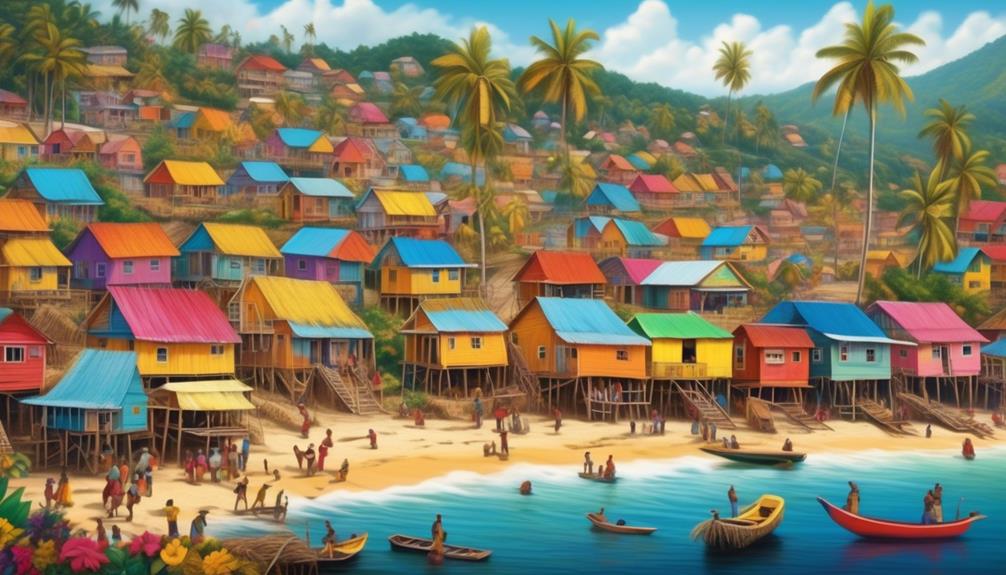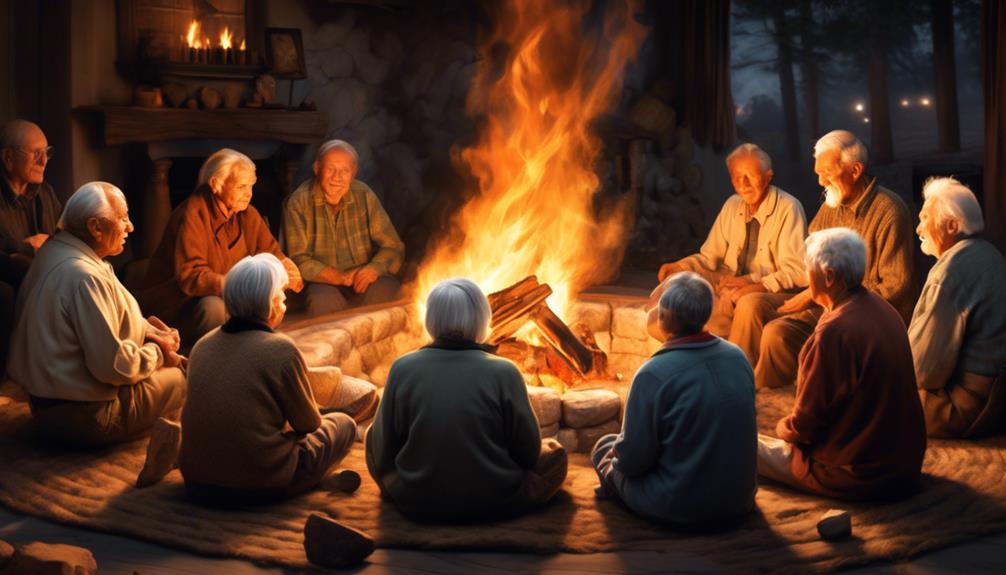Guatemala is comparable to a beautiful mosaic composed of colorful threads of indigenous communities that have flourished for centuries. The variety within these groups showcases the country’s cultural richness and the strong determination of its people.
From the ancient Maya civilization to the Garifuna community and the Xinca indigenous group, Guatemala is home to a mosaic of indigenous groups each with its own unique traditions, languages, and way of life.
But the tapestry is not complete without exploring the intricate threads of the Mestizo population and other indigenous communities that contribute to the colorful fabric of Guatemala's cultural landscape.
Join me as we unravel the fascinating stories of these indigenous groups and discover the profound impact they have on Guatemala's identity and history.
Key Takeaways
- Maya People: The Maya people have a rich cultural heritage and a deep connection to the land. They practice sustainable agricultural practices and have a wide array of rituals, ceremonies, and artistic expressions. They are known for their preservation of cultural traditions and resilience in the face of adversity.
- Garifuna Community: The Garifuna community in Guatemala is known for their vibrant music and dance, which are integral to their cultural and spiritual practices. They face challenges related to integration and cultural preservation, but they show resilience and advocate for their rights and heritage. They have a distinct connection to the land and a unique blend of African and Indigenous American influences.
- Xinca Indigenous Group: The Xinca indigenous group has a deep-rooted connection to the southern regions of Guatemala. They face challenges in preserving their endangered Xinca language, which is seen as a symbol of resilience and cultural legacy. They preserve their heritage through weaving, pottery, and spiritual ceremonies, but they have also historically faced marginalization and loss of ancestral lands.
- Mestizo Population: The Mestizo population in Guatemala represents a blending of Indigenous and European heritage, shaping the social fabric of the country. They have a rich historical legacy tracing back to the Spanish conquest and have fused traditions, languages, and customs from both backgrounds. Their cultural practices reflect the complex tapestry of the Mestizo identity.
The Maya People
The Maya people have a rich and diverse cultural heritage that has endured through centuries of history and continues to thrive in present-day Guatemala. Maya cultural traditions are deeply rooted in their agricultural practices, shaping their way of life and belief systems. The Maya have a deep connection to the land, viewing it as a sacred entity that sustains their communities. Their agricultural practices are a reflection of this reverence, as they utilize traditional farming methods such as terracing, crop rotation, and agroforestry to ensure sustainable cultivation and respect for the environment.
Maya cultural traditions also encompass a wide array of rituals, ceremonies, and artistic expressions that are intricately linked to their agricultural cycles. These traditions serve as a means of honoring their connection to the natural world, seeking harmony with the spirits, and celebrating the abundance provided by the earth. Through vibrant textiles, intricate pottery, and elaborate festivals, the Maya express their profound understanding of the land and its significance in their lives.
These cultural practices not only preserve their heritage but also serve as a testament to their resilience and enduring legacy in the face of adversity.
The Garifuna Community

Rooted in the rich tapestry of indigenous cultures in Guatemala, the Garifuna community embodies a vibrant heritage deeply intertwined with a distinct connection to the land and a unique blend of African and Indigenous American influences. The Garifuna people have a rich history and cultural traditions that have been passed down through generations, shaping their identity and way of life. Here are some key aspects of the Garifuna community:
- Cultural Traditions: The Garifuna community is known for its vibrant music and dance, such as punta and wanaragua, which are integral to their cultural and spiritual practices. These traditions serve as a way for the community to connect with their ancestors and celebrate their heritage.
- Integration Challenges: Despite their strong cultural identity, the Garifuna community faces challenges related to integration and preserving their traditions in the face of modernization. Issues such as land rights, economic opportunities, and cultural preservation are ongoing concerns for the Garifuna people.
- Resilience and Advocacy: Despite these challenges, the Garifuna community has shown resilience and continues to advocate for their rights and cultural preservation. Organizations and community leaders work tirelessly to protect and promote the cultural heritage of the Garifuna people, ensuring that their traditions remain alive for future generations.
The Xinca Indigenous Group
With a unique history and cultural heritage, the Xinca Indigenous Group embodies a rich tapestry of traditions and connections to the land in Guatemala. The Xinca people have a deep-rooted connection to the southern regions of Guatemala, particularly in the departments of Santa Rosa, Jalapa, and Jutiapa.
Xinca culture and traditions are intricately woven into their daily lives, reflecting their strong ties to the natural environment and their ancestors. The Xinca language, although endangered, is a crucial aspect of their identity, serving as a symbol of their resilience and cultural legacy.
Historically, the Xinca have faced significant challenges, including marginalization and the loss of their ancestral lands. Despite these obstacles, the Xinca community continues to preserve their heritage through traditional practices such as weaving, pottery, and spiritual ceremonies.
Their cultural resilience and determination to uphold their traditions are testament to the enduring strength of the Xinca Indigenous Group in Guatemala.
The Mestizo Population

Amidst the diverse cultural landscape of Guatemala, the Mestizo population holds a significant place, embodying a blending of Indigenous and European heritage that has shaped the country's social fabric. The unique Mestizo culture represents a fusion of traditions, languages, and customs from both Indigenous and Spanish backgrounds.
Here are three key aspects that shed light on the Mestizo population in Guatemala:
- Historical Legacy: The Mestizo population in Guatemala has a rich historical legacy, tracing back to the Spanish conquest and the subsequent mixing of European settlers with the Indigenous Mayan population. This historical blending has resulted in a unique cultural identity that's deeply intertwined with the country's heritage.
- Cultural Practices: Mestizo culture in Guatemala encompasses a wide array of traditions, including art, music, cuisine, and religious customs. These practices reflect the fusion of Indigenous and European influences, illustrating the complex tapestry of the Mestizo identity.
- Contemporary Significance: In contemporary Guatemala, the Mestizo population plays a pivotal role in shaping the nation's social, political, and economic landscapes. Their diverse heritage and cultural contributions continue to influence the country's development and identity.
The Mestizo population in Guatemala stands as a testament to the enduring legacy of Indigenous heritage in the country, exemplifying the resilience and richness of Guatemala's cultural mosaic.
Other Indigenous Communities
Exploring the cultural tapestry of Guatemala reveals the vibrant presence of numerous other indigenous communities, each contributing distinct traditions, languages, and customs to the country's rich and diverse heritage. Among these communities, we find the Xinca people, who predominantly reside in the southern region of Guatemala.
The Xinca community has a unique cultural identity, with their own language and traditions. Their language, also called Xinca, is part of the Hokan family of languages and is considered endangered. Efforts are being made to preserve and revitalize the Xinca language, as it plays a vital role in maintaining their cultural heritage. The Xinca people have rich traditions in pottery, weaving, and agriculture, which are integral to their way of life.
In addition to the Xinca, there are the Garifuna people, who've a strong presence along the Caribbean coast of Guatemala. The Garifuna community is known for their vibrant music and dance, as well as their traditional cuisine, which reflects a blend of African, Caribbean, and indigenous influences. The Garifuna language, a member of the Arawakan language family, is also an essential part of their cultural identity, and efforts are being made to preserve it.
These are just a few examples of the many indigenous communities in Guatemala, each with its own unique languages and cultural traditions, contributing to the country's rich and diverse cultural landscape.
Frequently Asked Questions
What Are the Traditional Clothing and Adornments Worn by the Maya People?
Traditional clothing worn by the Maya people holds deep cultural significance. Maya textiles are intricately woven and often feature vibrant colors and intricate patterns.
Ceremonial attire is adorned with symbolic elements representing the connection to nature, spirituality, and the community. The traditional clothing reflects the rich heritage and identity of the Maya people, showcasing their skilled craftsmanship and preserving their unique cultural traditions.
How Do the Garifuna People Preserve Their Unique Cultural Traditions and Practices?
We study how the Garifuna people preserve their unique cultural traditions and practices.
Cultural preservation is vital for the Garifuna community, and music plays a central role.
Through the rhythmic beats of drums and the expressive dance movements, Garifuna music encapsulates their history and traditions.
It serves as a powerful tool for passing down their heritage to future generations, ensuring that their cultural identity remains vibrant and alive.
What Language Do the Xinca People Speak and What Efforts Are Being Made to Preserve It?
We're currently researching the efforts to preserve the language of the Xinca people in Guatemala.
It's fascinating to explore the cultural heritage preservation initiatives aimed at maintaining the linguistic traditions of this indigenous group.
The Xinca language, along with its unique nuances and historical significance, is being actively safeguarded through various community-driven programs and educational initiatives.
These efforts are crucial in ensuring the continuity of the Xinca cultural legacy.
What Are the Typical Foods and Dishes Associated With the Mestizo Population in Guatemala?
Mestizo cuisine in Guatemala is a rich tapestry of flavors, influenced by Spanish, Indigenous, and African culinary traditions. Popular dishes like pepián and kak'ik showcase traditional ingredients and cooking techniques, with regional variations adding depth to the culinary landscape.
The cultural significance of food preservation techniques is evident in dishes like jocón and tamales. Culinary influences from diverse groups have shaped Mestizo cuisine, creating a vibrant and dynamic food culture.
What Are Some of the Lesser-Known Indigenous Communities in Guatemala and What Distinguishes Their Cultural Practices?
We found that Guatemala hosts over 20 indigenous groups, each with unique cultural practices.
Indigenous festivals and rituals play a significant role in their communities, reflecting their deep-rooted cultural beliefs and customs.
For example, the K'iche' Mayan community celebrates the 'Feria de San Andrés' with traditional music, dance, and food, showcasing their vibrant heritage.
These lesser-known indigenous communities contribute to the rich tapestry of Guatemala's cultural diversity.
Conclusion
In Guatemala, the diverse indigenous groups symbolize the rich cultural tapestry of the country. Each group brings a unique history, language, and traditions, adding depth and meaning to the Guatemalan identity.
As we continue to learn about and respect these indigenous communities, we can embrace the interconnectedness of all people and the importance of preserving and celebrating cultural heritage.
Let's strive to build a future where the contributions of all indigenous groups are valued and honored.
Mary is a passionate writer who brings creativity and a fresh perspective to our team. Her words have the power to captivate and inspire, making her an essential contributor to our content. Mary’s commitment to storytelling and dedication to promoting Indigenous culture ensures that her work touches the hearts of our readers. We’re fortunate to have her as part of our team.










